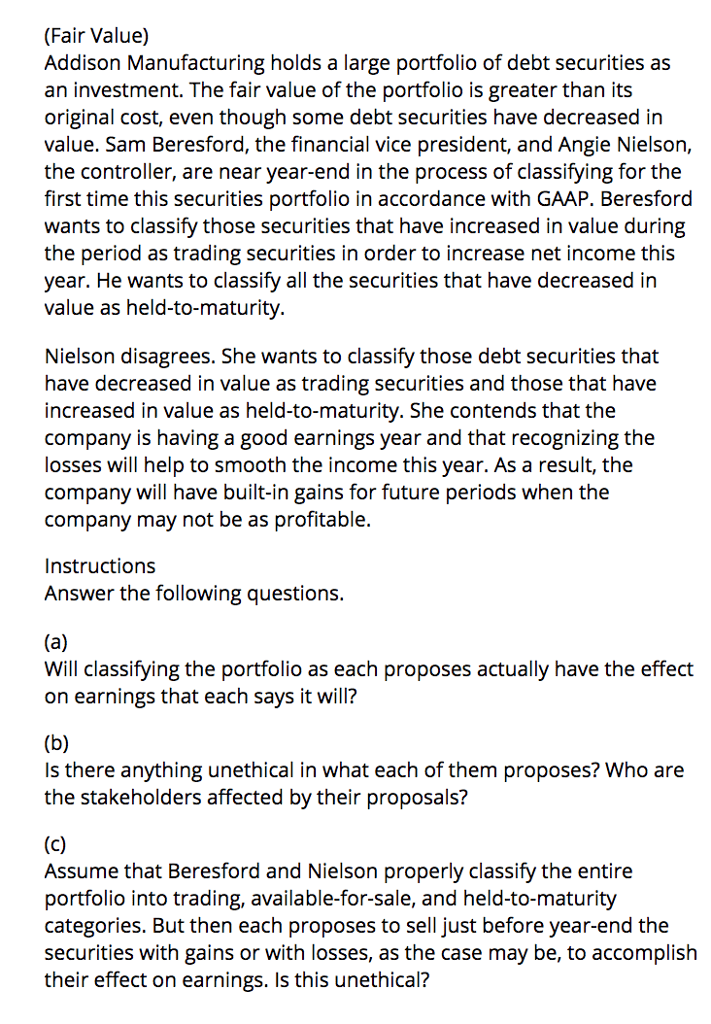sujalpawar038
sujal pawar
0 Followers
0 Following
0 Helped
21 May 2023
Answer: As part of the team retrieving a deep-sea worm from the Mariana Trench...
21 May 2023
Answer: The Mariana Trench is the deepest part of the Earth's oceans. It reach...
18 May 2023
Answer: (a) Schedule of Securities Fair Value Adjustment (Trading) at December...
18 May 2023
Answer: a. The proper valuation for the trading securities on December 31, 201...
18 May 2023
Answer: The major difference in the accounting treatment between trading secur...
18 May 2023
Answer: (a) Classifying the securities as Faust and McCabe suggest will indeed...
18 May 2023
Answer: To prove these statements, we'll use the definitions and properties of...
18 May 2023
Answer: (a) Classifying the portfolio as each proposes will have the effect on...
18 May 2023
Answer: (a) Classifying the portfolio as each proposes will have the effect on...
18 May 2023
Answer: 1. The four steps to smart buying are: a. Research: Gather information...
18 May 2023
Answer: 1. The four steps to smart buying are: a. Research: Gather information...
18 May 2023
Answer: Human Resource Management (HRM) as a formal discipline and profession ...
17 May 2023
Answer: When determining the fair value of equity investments, the treatment c...
17 May 2023
Answer: (a) Classifying the portfolio as proposed by each individual would hav...
17 May 2023
Answer: To estimate the value of the integral ∫[5, 16] x dx, we can use the pr...
17 May 2023
Answer:(a) Classifying the portfolio as proposed by each individual would have...
17 May 2023
Answer:(a) Classifying the portfolio as proposed by each individual would have...
15 May 2023
Answer: 1. Classifying the portfolio as Beresford proposes, with securities th...
15 May 2023
Answer: 1. Classifying the portfolio as Julia proposes, with securities that h...
15 May 2023
Answer: 1. The best evidence to support the claim that NATO's activities in Ir...
15 May 2023
Answer:The Honourable Lincoln M. Alexander, a prominent figure in Canadian his...
15 May 2023
Answer: Step-by-step explanation: Example of continuing efforts by African Ame...
15 May 2023
Answer: Claim: Yes, the North Atlantic Treaty Organization (NATO) is still rel...
15 May 2023
Answer: 1. Classifying the portfolio as proposed by Julia and Sam may have som...
15 May 2023
Answer: Step-by-step explanation:1. Classifying the portfolio as proposed by J...
15 May 2023
Answer: No, the city should not recognize a gain from the decrease in the valu...
15 May 2023
Answer: The correct answer is: B. As the shareholder experiences a loss, the c...
15 May 2023
Answer: The hydrostatic force on one end of the aquarium is approximately 1,04...
15 May 2023
Answer: Step-by-step explanation: Title: Taking Care of Your Health: Exploring...
15 May 2023
Answer: a. The velocity of the object after t seconds is -23.6 m/s. b. The hei...
15 May 2023
Answer:Therefore, it would take approximately 3.96 seconds for the rock to rea...
15 May 2023
Answer: So, it would take approximately 2.90 seconds for the rock to reach a v...
15 May 2023
Answer: Step-by-step explanation: As of my knowledge cutoff in September 2021,...


